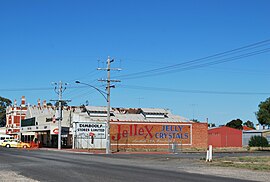Dimboola, Victoria
|
Dimboola Victoria |
|
|---|---|

Shops in Dimboola
|
|
| Coordinates | 36°27′0″S 142°01′0″E / 36.45000°S 142.01667°ECoordinates: 36°27′0″S 142°01′0″E / 36.45000°S 142.01667°E |
| Population | 1,662 (2011 census) |
| Postcode(s) | 3414 |
| Location | |
| LGA(s) | Shire of Hindmarsh |
| State electorate(s) | Lowan |
| Federal Division(s) | Mallee |
Dimboola is a town in the Shire of Hindmarsh in the Wimmera region of western Victoria, Australia, 334 kilometres north-west of Melbourne.
Situated on the Wimmera River , Dimboola was previously known as 'Nine Creeks'. Following a survey conducted in late 1862 by contractor Frederick Smith of Ararat, a plan for a township in the County of Dimboola was proposed. It was first recognised as being a township when mentioned in the April 1863 edition of the Government Gazette. At the 2011 census Dimboola had a population of 1,662.
Before the arrival of white people into the district, the Aborigines called the area Watchegatcheca which had the meaning 'Wattle Tree and White Cockatoos'. The name 'Dimboola' has generally been accepted to have come from the Sinhalese word "dimbula" meaning 'Land of Figs'. The name came from the District Surveyor of the time John George Winchester Wilmot, who had previously lived in Ceylon (now Sri Lanka). The relationship of the name to this area is suggested to have come from 'Upper Regions Station' where an abundance of fruit trees grew in the garden, many of which were figs.
The Post Office opened on 3 April 1863, but was known as Nine Creeks until 1869.
Dimboola's economy is predominantly rural, with wheat, sheep and timber being traditionally important. There have been recent forays into emu and alpaca rearing and olive plantations.
Paintings of Dimboola landscapes by noted Australian painter Sidney Nolan, who was stationed in the area while on army duty in World War II, can be found in the National Gallery of Victoria. Dimboola is also the setting of the play (and subsequent film) Dimboola by Jack Hibberd.
...
Wikipedia

